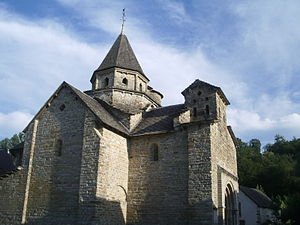L'Hôpital-Saint-Blaise
|
L'Hôpital-Saint-Blaise Ospitalepea |
||
|---|---|---|
|
|
||
| region | Nouvelle-Aquitaine | |
| Department | Pyrénées-Atlantiques | |
| Arrondissement | Oloron-Sainte-Marie | |
| Canton | Montagne Basque | |
| Community association | Pays Basque | |
| Coordinates | 43 ° 15 ′ N , 0 ° 46 ′ W | |
| height | 147-254 m | |
| surface | 2.11 km 2 | |
| Residents | 69 (January 1, 2017) | |
| Population density | 33 inhabitants / km 2 | |
| Post Code | 64130 | |
| INSEE code | 64264 | |
| Website | www.hopital-saint-blaise.fr | |
 12th century church of L'Hôpital-Saint-Blaise |
||
L'Hôpital-Saint-Blaise (on Basque Ospitalepea ), is a French municipality with 69 inhabitants (at January 1, 2017) in the department of Pyrénées-Atlantiques in the region Nouvelle-Aquitaine . It lies in the area of the former Basque province of Soule , where it is one of the most eastern municipalities. The inhabitants are called Ospitales .
geography
L'Hôpital-Saint-Blaise is located on the Lausset , a left tributary of the Gave d'Oloron . It borders on the municipalities of Moncayolle-Larrory-Mendibieu and Chéraute to the west and Barcus to the south .
Place names
The place Hôpital Saint-Blaise appears historically under the names La Commanderie de Misericordi (1334, notaries from Oloron ), Saint-Blas (1670, State order of Navarre ) and L'Hôpital de Saint-Blaise de Misericorde (18th century, Intendantur from Pau ).
history
L'Hôpital Saint-Blaise was founded in the Middle Ages to care for the (sick) pilgrims on the Way of St. James to Santiago de Compostela . Augustinian monks from the Santa Cristina monastery on the Col du Somport built a hôpital de miséricorde (“Hostel of Mercy”) here in the middle of the 12th century . The term “hospital” is only the customary description. In the hierarchy of the monastery it was a commandery (French: commanderie ). The first written mention comes from 1308.
The hostel was probably demolished during the French Revolution. Today only the church still exists, which has been part of the UNESCO World Heritage "Camino de Santiago in France" since 1998 .
Anyone traveling to Spain on the Via Tolosana usually used the pass crossing at Col du Somport . However, those who preferred to cross the Col de Roncevaux like pilgrims from northern regions chose the path down the valley in Oloron-Sainte-Marie and reached the Via Podiensis near Ostabat . On this section of the route, Hôpital Saint-Blaise is where the valley of the Gave is left to the west.
Saint Blaise is considered the patron saint of shepherds, woolen combs and stonemasons. A three-day pilgrimage in his honor took place regularly in early February. Animal hair, feathers and similar products from farm animals were thrown into a fire in the village square to ask for the cattle to be protected.
Economy and Infrastructure
The community is mainly agricultural (maize and cattle breeding).
Culture and sights
The ocher-colored slate church has been on the list of monuments since 1888 . Its style is a mixture of Romanesque- Navarre and Byzantine architecture: it has the shape of a Greek cross with an octagonal tower in the middle that rises above a dome with Hispanic-Moorish influences. The dimensions are modest at 18 meters in length and 12 meters in width.
The entrance on the west side is through a richly decorated portal under a small bell tower. Only parts of the jewelry in the tympanum are still original; most of the parts were faithfully reconstructed during a restoration at the beginning of the 20th century.
Except for the windows in the choir and in the two chapels in the transepts , all niches are provided with stone balustrades ( transennes ), the individual columns of which have a variety of geometric shapes. These architectural elements, which come from an Islamic and pre-Romanesque tradition, cannot be found in such completeness in any other French church. Equally unique is the choir's eaves made of wooden planks, decorated in the Mudejar style . Age determinations showed that they actually come from the 12th century.
Most of the windows have fan arches on the inside . The octagonal dome rises above a smooth trompe . Its construction with double-crossed arches that form an octagonal star is reminiscent of Moorish models.
More Attractions
- A mill is currently being restored.
Individual evidence
- ^ Paul Raymond: Dictionnaire Topographique du Département des Basses-Pyrénées. Imprimerie Impériale, Paris 1863, ( digitized ).
- ↑ Notaires d'Oloron - Archives départementales des Pyrénées-Atlantiques
- ↑ Titres de l'intendance de Pau - Archives départementales des Pyrénées-Atlantiques
- ^ Philippe Veyrin: Les Basques. De Labourd, de Soule et de Basse Navarre. Leur histoire et leurs traditions. Arthaud, Grenoble 1975, ISBN 2-7003-0038-6 , p. 111.
Web links
- WHC Nomination Documentation (PDF, 88.9 MB!), Application documents for the nomination as World Heritage, here: Section "L'Hôpital Saint-Blaise, Eglise"

